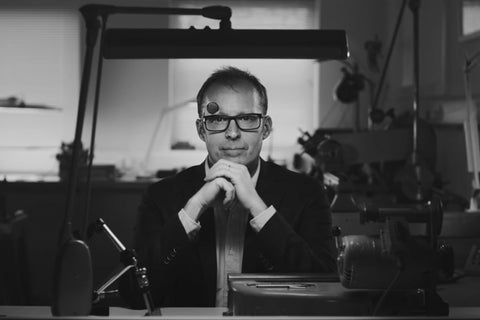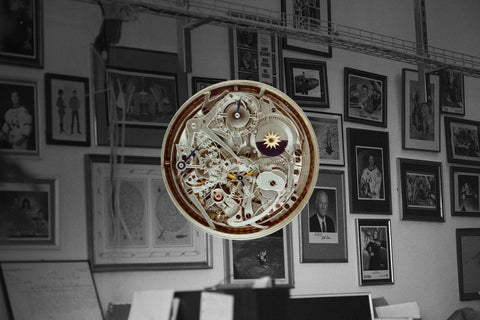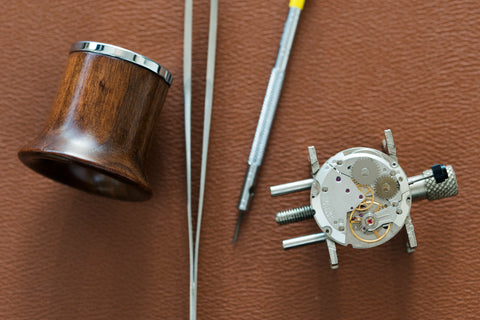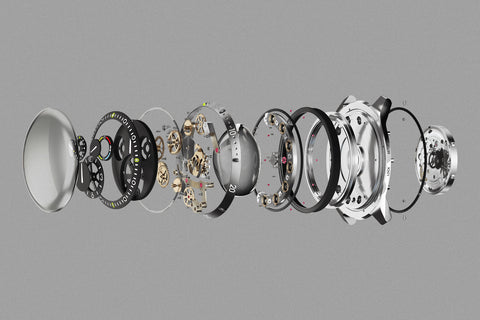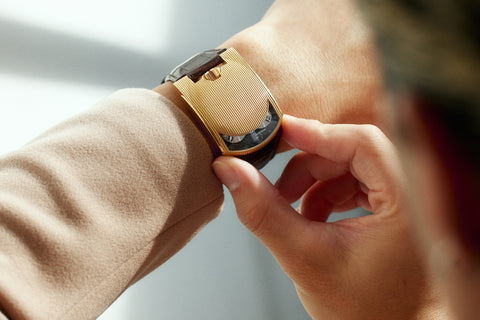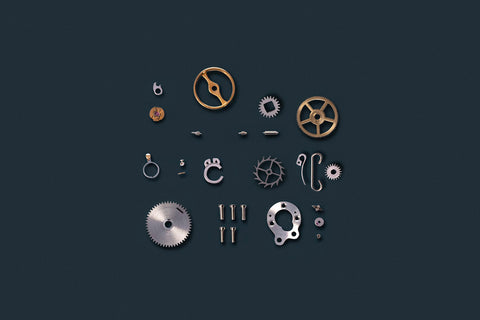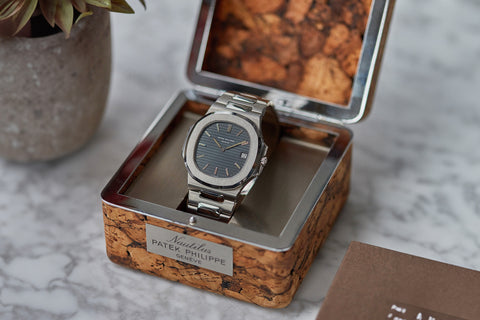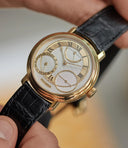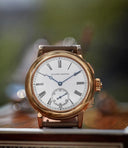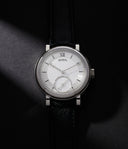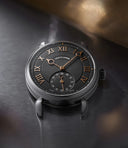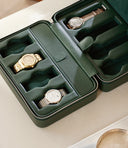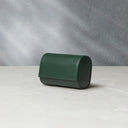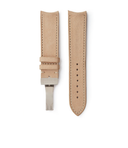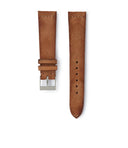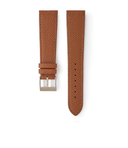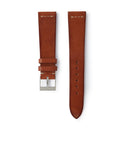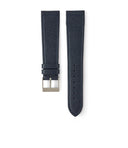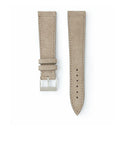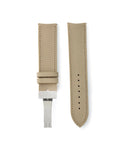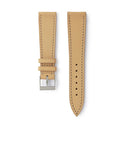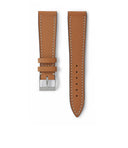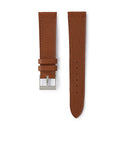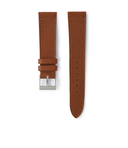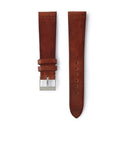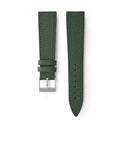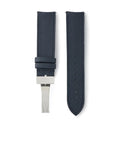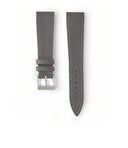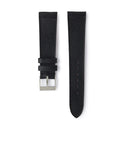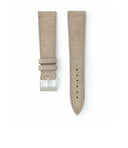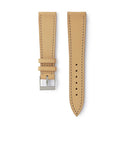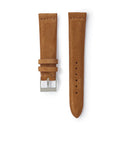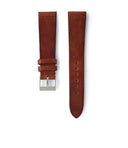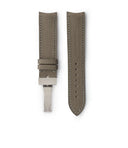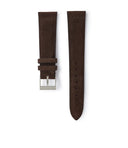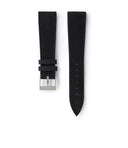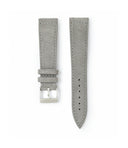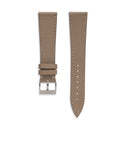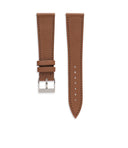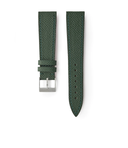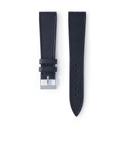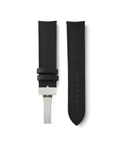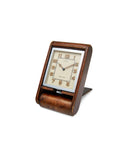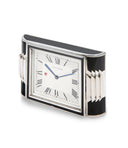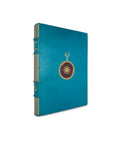Dr George Daniels is recognised as one of the greatest watchmakers of the 20th century. In 1981, he received an MBE for his services to horology, along with a CBE in 2010 – the first watchmaker ever to receive such an honour. During his career, Daniels was one of the few people who built complete watches by hand, from his workshop on the Isle of Man, at a rate of around one watch per year.
First designed to mark 35 years since Daniels conceived of the design of the Co-Axial escapement, the 35-piece Anniversary series holds a special place in the master watchmaker’s canon. Like the Millennium before it, the Anniversary was designed during Daniels' lifetime.
The watch is rich not just with the history of the name on the dial, but because it marked the beginning of a new chapter – the coming-of-age for Daniels’ sole apprentice and protégé, Roger W. Smith. After having worked mostly solitarily for much of his career, Daniels had called on his only apprentice and heir apparent to help complete the Anniversary series. This was after Smith had shown promise by making two pocket watches entirely by hand using the Daniels method over the course of several years.
Drawing on Daniels’ body of work, the pair created an entirely new calibre for the Anniversary series, which was then produced, cased and finished by Smith, to Daniels’ exacting standards and style. Speaking to us, Smith says, “I spent a year trying to get into George’s head, studying his body of work. It was an honour to have been entrusted by George to create this new watch, and I wanted to live up to it.”
This process yielded two watches that were finished by 2012. The first was a dummy prototype, with no functioning calibre. Its purpose was to hone the aesthetics. This example – on loan from The Worshipful Company of Clockmakers – today lives at the Science Museum in London.
This is the only functioning prototype, fitted with a newly designed manually wound calibre with Smith’s first innovation – the single-wheel variant of the Daniels Co-Axial escapement. It features several aesthetic details wholly unique to it and is further distinguished by being Daniels’ personal watch for some time. The master watchmaker, who passed away in 2011, left this Anniversary prototype to his close friend of more than 50 years, and chairman of trustees of The George Daniels Educational Trust, David Newman.
Says Smith, “George and David had a deep relationship built over many decades, and they had a common passion for cars and watchmaking. As George got older, David used to come over to the Isle of Man more and more often, helping set up the trust and also helped him get his personal affairs in order. It was fitting that George bequeathed this prototype to David as recognition of their relationship.”
Crafted from yellow gold, the 40mm case features a rounded, double stepped bezel, elemental to Daniels’ aesthetic. Matching it in shape are the rounded profiles of the polished mid-case as well as the caseback. The corrector on the midcase at 9 o’clock helps set the date.
The dial, made entirely in-house and engraved by master horological engraver Charles Scarr, draws lineage from the historically important Daniels chronograph pocket watch, says Smith. It features a range of engine-turned patterns on the silver base. The outer reaches of the dial are decorated in a barleycorn pattern while inside the brushed chapter of black engraved Roman numeral indices the dial wears a diagonally oriented basket weave. The date register at 8 o’clock is differentiated with a hobnail pattern while the subsidiary seconds at 4 o’clock features a horizontally oriented basket-weave.
While the inlaid gold satiné circulaire chapter of engraved Roman indices is interrupted, the ring of minutes outside it runs through the two subsidiary registers. A similar chapter outlines the subsidiary seconds register while the date register features a chapter with Arabic numerals.
This in fact is one of several points of distinction – while the Anniversary typically has a date chapter ending with the 31st, in this prototype the end of the month is denoted with a diamond index. Another detail worth noting is the stylised 6 o’clock engraving. Master engraver, Charles Scarr – who was a long-time Daniels collaborator and responsible for engraving the Millennium and much of the Anniversary series – was clearly experimenting on his way to finding the right aesthetic for the Anniversary.
At 12 o’clock is a fan-style reserve indicator. The stick-style hands are another Daniels hallmark, as is the hour hand with the arrow pointer.
The caseback is also point of uniqueness. While on the production watch, the edges of exhibition caseback feature a rope-style fluting, on this prototype it is a simple dodecagon screwed back design. Says Smith, “It was another detail we were experimenting with. We also put the hallmarks on the backs of the lugs, instead of on the rim of the caseback. However, in the end, we realised this aspect had to be tidied up and refined. For the knurled style of the caseback, I again lifted it from George’s past work.”
The calibre, undeniably Daniels in its functional aesthetic, is actually heavily influenced by Smith. Another example of Smith’s understanding of Daniel’s watchmaking, it was largely conceived by the former according to Daniels’ methods, featuring his innovation on the Co-Axial escapement – a single wheeled variant. This version of the Co-Axial builds upon the two-piece design originally conceived by Daniels, aiming to improve its efficiency. It was Smith’s first significant improvement and combined the upper and lower wheels essentially into one by adding raised teeth on the lower wheel. As a result, the escape wheel could be made in a single operation and this minimised potential for error.
True to traditions of English watchmaking, the manually wound calibre wears frosted gold finishing, with the letter ‘P’ in place of the serial number, maker’s mark and the words ‘Co-Axial escapement’ etched on the bridge. Also notable, is a cartouche with the triskelion motif of the Isle of Man – while on production examples, this resides on the baseplate next to the fourth wheel of the gear train, on this prototype it is placed on the trapezoidal bridge that anchors the fourth wheel.
The architecture gives the movement considerable visual depth and interest, while all fine finishing, including the engraving, is done manually. It is truly special, having been created by the hands of some of the greatest horological craftspeople of our time.
This particular watch comes with its original black alligator strap and substantial signed 18-carat folding clasp, with twin release buttons. The finely crafted pusher tool is part of the set, as is the user manual and the beautiful royal blue Daniels box, with gold leaf detailing.
The prototype of the Anniversary is rich with history and provenance. As the blueprint for the last reference to bear his name, and the fact that Daniels left the watch to one of his closest friends, makes this one of the most significant finds of horological history.










